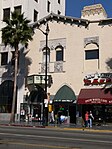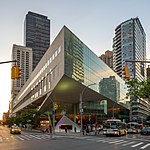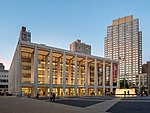Lincoln Arcade
The Lincoln Arcade was a commercial building near Lincoln Square in the Upper West Side of Manhattan, New York City, just west of Central Park. Built in 1903, it was viewed by contemporaries as a sign of the northward extension of business-oriented real estate ventures, and the shops, offices, and other enterprises. Soon after it opened, however, the building was becoming known for some considerably less conventional residents. One observer styled some of these newcomers as "starving students, musicians, actors, dead-beat journalists, nondescript authors, tarts, polite swindlers, and fugitives from injustice.": 250 Many others were aspiring artists. Most of these men and women received little attention from the public either during their lives or since their deaths, but some, such as George Bellows, Thomas Hart Benton, Stuart Davis, Marcel Duchamp, Eugene O'Neill, and Lionel Barrymore, became famous. The Lincoln Arcade was destroyed in 1960.
Excerpt from the Wikipedia article Lincoln Arcade (License: CC BY-SA 3.0, Authors).Lincoln Arcade
Broadway, New York Manhattan
Geographical coordinates (GPS) Address Nearby Places Show on map
Geographical coordinates (GPS)
| Latitude | Longitude |
|---|---|
| N 40.7738 ° | E -73.9828 ° |
Address
Broadway 1945
10023 New York, Manhattan
New York, United States
Open on Google Maps






